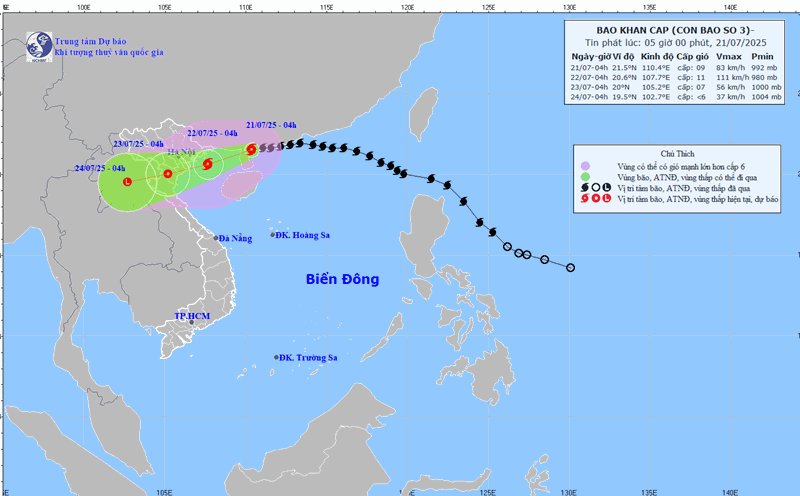This morning, July 21, Typhoon No. 3 crossed the northern part of the Lusian Peninsula (China), entering the northern Gulf of Tonkin. At 10:00 a.m., the center of the storm was at about 21.2 degrees north latitude; 109.6 degrees east longitude, about 190 km east of Quang Ninh, about 310 km east of Hai Phong, about 340 km east-northeast of Hung Yen, about 360 km east-northeast of Ninh Binh. The strongest wind near the storm center is level 9 (75-88 km/h), gusting to level 11. The storm is moving west-southwest at a speed of 10-15 km/h.
It is forecasted that in the next 12 hours, the storm will move west-southwest at a speed of about 10-15 km/h and is likely to strengthen. At 10:00 p.m. on July 21, the center of the storm was at about 20.7 degrees north latitude; 108.2 degrees east longitude, in the northern Gulf of Tonkin. The strongest wind near the storm center is level 10-11, gusting to level 14.
The dangerous area in the next 12 hours will be north of latitude 18.5 degrees north; from longitude 106 degrees east to 112 degrees east. The risk level of natural disasters due to the storm is level 3 for the affected area, including the northwest sea area of the northern East Sea, the Gulf of Tonkin, and coastal waters of the provinces from Quang Ninh to Ninh Binh.
It is forecasted that in the next 24 hours, the storm will continue to move west-southwest at a speed of about 10-15 km/h. At 10:00 on July 22, the center of the storm was at about 20.3 degrees north latitude; 106.8 degrees east longitude, in the sea from Hai Phong to Thanh Hoa. The strongest wind near the storm center is level 10-11, gusting to level 14.
The dangerous area in the next 24 hours will be north at 18.5 degrees north latitude; west at 110 degrees east longitude. The disaster risk level is level 3 for affected areas including the Gulf of Tonkin, coastal waters and mainland provinces from Quang Ninh to Nghe An.
It is forecasted that in the next 48 hours, the storm will move west-southwest at a speed of about 10-15 km/h and gradually weaken into a low pressure area. At 10:00 on July 23, the center of the low pressure area was at about 19.7 degrees north latitude; 104.3 degrees east longitude, on the mainland of upper Laos. Wind power below level 6.
The dangerous area in the next 48 hours will be north of 18 degrees north latitude; west of 109 degrees east longitude. The natural disaster risk level is level 3 for affected areas including the Gulf of Tonkin, coastal waters and mainland provinces from Quang Ninh to Nghe An.
Regarding the impact of the storm at sea, the northwestern sea area of the northern East Sea will have strong winds of level 7-8, gusts of level 10, waves 3-5 m high, and rough seas.
The northern Gulf of Tonkin sea area, including the islands of Bach Long Vi, Co To, Van Don, Cat Hai, Hon Dau, has strong winds of level 6-7, then increasing to level 8-9, the area near the storm's eye has level 10-11, gusting to level 14. Waves 2-4 m high, near the center of the storm 4-6 m, the sea is rough.
The southern Gulf of Tonkin sea area, including Hon Ngu island, will have winds gradually increasing to level 6-7, near the storm center level 8-9, gusts of level 11, waves 2-4 m high, very rough seas.
Coastal areas from Hung Yen to Quang Ninh have storm surge water from 0.5-1.0 m. The water level in Ba Lat (Hung Yen) is 2.4-2 1.6 m high, in Hon Dau (Hai Phong) is 3.9-4.3 m high, in Cua Ong (Quang Ninh) is 4.6-5.0 m high and in Tra Co (Quang Ninh) is 3.6-4.0 m high. There is a high risk of flooding in coastal areas and river mouths on the afternoon of July 22.
On land, from the evening and night of July 21, coastal areas from Quang Ninh to Nghe An will have winds gradually increasing to level 7-9, near the storm center level 10-11, gusting to level 14. Deep inland areas of provinces and cities such as Hai Phong, Hung Yen, Ninh Binh and Thanh Hoa have strong winds of level 6, gusting to level 7-8. Winds of level 10-11 can cause trees, electric poles to fall, and roofs to fall, causing very heavy damage.
Regarding heavy rain, from July 21 to July 23, the Northeast region, the Northern Delta, Thanh Hoa and Nghe An will have heavy to very heavy rain and thunderstorms with common rainfall of 200-350 mm, some places over 600 mm. Other places in the Northern region and Ha Tinh will have moderate rain, heavy rain, some places will have very heavy rain and thunderstorms with common rainfall of 100-200 mm, some places over 300 mm. Warning of the risk of heavy rain over 150 mm in 3 hours. Heavy rainfall in a short period of time can cause flash floods, landslides in mountainous areas, and flooding in low-lying areas.
The meteorological agency warns that the weather at sea and in coastal mainland areas during the storm is extremely dangerous, unsafe for any vehicles or works operating in the dangerous area such as tourist boats, passenger ships, transport ships, cages, aquaculture areas, dykes, embankments, coastal roads. Vehicles are likely to overturn, be destroyed, or be flooded due to strong winds, thunderstorms, whirlwinds, large waves, and rising sea levels.











